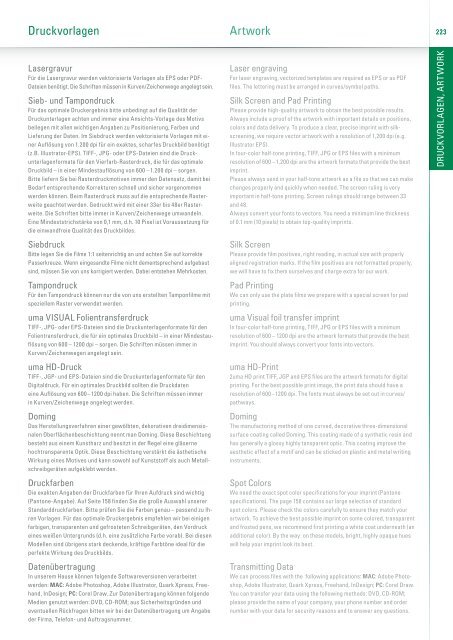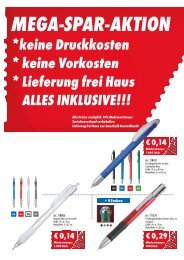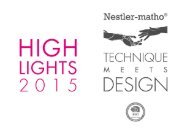UMA_HK_2015
You also want an ePaper? Increase the reach of your titles
YUMPU automatically turns print PDFs into web optimized ePapers that Google loves.
Druckvorlagen<br />
Artwork<br />
223<br />
Lasergravur<br />
Für die Lasergravur werden vektorisierte Vorlagen als EPS oder PDF-<br />
Dateien benötigt. Die Schriften müssen in Kurven/Zeichenwege angelegt sein.<br />
Sieb- und Tampondruck<br />
Für das optimale Druckergebnis bitte unbedingt auf die Qualität der<br />
Druckunterlagen achten und immer eine Ansichts-Vorlage des Motivs<br />
beilegen mit allen wichtigen Angaben zu Positionierung, Farben und<br />
Lieferung der Daten. Im Siebdruck werden vektorisierte Vorlagen mit einer<br />
Auflösung von 1.200 dpi für ein exaktes, scharfes Druckbild benötigt<br />
(z.B. Illustrator-EPS). TIFF-, JPG- oder EPS-Dateien sind die Druckunterlagenformate<br />
für den Vierfarb-Rasterdruck, die für das optimale<br />
Druckbild – in einer Mindestauflösung von 600 – 1.200 dpi – sorgen.<br />
Bitte liefern Sie bei Rasterdruckmotiven immer den Datensatz, damit bei<br />
Bedarf entsprechende Korrekturen schnell und sicher vorgenommen<br />
werden können. Beim Rasterdruck muss auf die entsprechende Rasterweite<br />
geachtet werden. Gedruckt wird mit einer 33er bis 48er Rasterweite.<br />
Die Schriften bitte immer in Kurven/Zeichenwege umwandeln.<br />
Eine Mindeststrichstärke von 0,1 mm, d.h. 10 Pixel ist Voraussetzung für<br />
die einwandfreie Qualität des Druckbildes.<br />
Siebdruck<br />
Bitte legen Sie die Filme 1:1 seitenrichtig an und achten Sie auf korrekte<br />
Passerkreuze. Wenn eingesandte Filme nicht dementsprechend aufgebaut<br />
sind, müssen Sie von uns korrigiert werden. Dabei entstehen Mehrkosten.<br />
Tampondruck<br />
Für den Tampondruck können nur die von uns erstellten Tamponfilme mit<br />
speziellem Raster verwendet werden.<br />
uma VISUAL Folientransferdruck<br />
TIFF-, JPG- oder EPS-Dateien sind die Druckunterlagenformate für den<br />
Folientransferdruck, die für ein optimales Druckbild – in einer Mindestauflösung<br />
von 600 – 1200 dpi – sorgen. Die Schriften müssen immer in<br />
Kurven/Zeichenwegen angelegt sein.<br />
uma HD-Druck<br />
TIFF-, JGP- und EPS-Dateien sind die Druckunterlagenformate für den<br />
Digitaldruck. Für ein optimales Druckbild sollten die Druckdaten<br />
eine Auflösung von 600 – 1200 dpi haben. Die Schriften müssen immer<br />
in Kurven/Zeichenwege angelegt werden.<br />
Doming<br />
Das Herstellungsverfahren einer gewölbten, dekorativen dreidimensionalen<br />
Oberflächenbeschichtung nennt man Doming. Diese Beschichtung<br />
besteht aus einem Kunstharz und besitzt in der Regel eine gläserne<br />
hochtransparente Optik. Diese Beschichtung verstärkt die ästhetische<br />
Wirkung eines Motives und kann sowohl auf Kunststoff als auch Metallschreibgeräten<br />
aufgeklebt werden.<br />
Druckfarben<br />
Die exakten Angaben der Druckfarben für Ihren Aufdruck sind wichtig<br />
(Pantone-Angabe). Auf Seite 158 finden Sie die große Auswahl unserer<br />
Standarddruckfarben. Bitte prüfen Sie die Farben genau – passend zu Ihren<br />
Vorlagen. Für das optimale Druckergebnis empfehlen wir bei einigen<br />
farbigen, transparenten und gefrosteten Schreibgeräten, den Vordruck<br />
eines weißen Untergrunds (d.h. eine zusätzliche Farbe vorab). Bei diesen<br />
Modellen sind übrigens stark deckende, kräftige Farbtöne ideal für die<br />
perfekte Wirkung des Druckbilds.<br />
Datenübertragung<br />
In unserem Hause können folgende Softwareversionen verarbeitet<br />
werden: MAC: Adobe Photoshop, Adobe Illustrator, Quark Xpress, Freehand,<br />
InDesign; PC: Corel Draw. Zur Datenübertragung können folgende<br />
Medien genutzt werden: DVD, CD-ROM; aus Sicherheitsgründen und<br />
eventuellen Rückfragen bitten wir bei der Datenübertragung um Angabe<br />
der Firma, Telefon- und Auftragsnummer.<br />
Laser engraving<br />
For laser engraving, vectorized templates are required as EPS or as PDF<br />
files. The lettering must be arranged in curves/symbol paths.<br />
Silk Screen and Pad Printing<br />
Please provide high-quality artwork to obtain the best possible results.<br />
Always include a proof of the artwork with important details on positions,<br />
colors and data delivery. To produce a clear, precise imprint with silkscreening,<br />
we require vector artwork with a resolution of 1,200 dpi (e.g.<br />
Illustrator EPS).<br />
In four-color half-tone printing, TIFF, JPG or EPS files with a minimum<br />
resolution of 600 – 1,200 dpi are the artwork formats that provide the best<br />
imprint.<br />
Please always send in your half-tone artwork as a file so that we can make<br />
changes properly and quickly when needed. The screen ruling is very<br />
important in half-tone printing. Screen rulings should range between 33<br />
and 48.<br />
Always convert your fonts to vectors. You need a minimum line thickness<br />
of 0.1 mm (10 pixels) to obtain top-quality imprints.<br />
Silk Screen<br />
Please provide film positives, right reading, in actual size with properly<br />
aligned registration marks. If the film positives are not formatted properly,<br />
we will have to fix them ourselves and charge extra for our work.<br />
Pad Printing<br />
We can only use the plate films we prepare with a special screen for pad<br />
printing.<br />
uma Visual foil transfer imprint<br />
In four-color half-tone printing, TIFF, JPG or EPS files with a minimum<br />
resolution of 600 – 1200 dpi are the artwork formats that provide the best<br />
imprint. You should always convert your fonts into vectors.<br />
uma HD-Print<br />
2uma HD print TIFF, JGP and EPS files are the artwork formats for digital<br />
printing. For the best possible print image, the print data should have a<br />
resolution of 600 – 1200 dpi. The fonts must always be set out in curves/<br />
pathways.<br />
Doming<br />
The manufactoring method of one curved, decorative three-dimensional<br />
surface coating called Doming. This coating made of a synthetic resin and<br />
has generally a glossy highly tansparent optic. This coating improve the<br />
aesthetic effect of a motif and can be sticked on plastic and metal writing<br />
instruments.<br />
Spot Colors<br />
We need the exact spot color specifications for your imprint (Pantone<br />
specifications). The page 158 contains our large selection of standard<br />
spot colors. Please check the colors carefully to ensure they match your<br />
artwork. To achieve the best possible imprint on some colored, transparent<br />
and frosted pens, we recommend first printing a white coat underneath (an<br />
additional color). By the way: on these models, bright, highly opaque hues<br />
will help your imprint look its best.<br />
Transmitting Data<br />
We can process files with the following applications: MAC: Adobe Photoshop,<br />
Adobe Illustrator, Quark Xpress, Freehand, InDesign; PC: Corel Draw.<br />
You can transfer your data using the following methods: DVD, CD-ROM;<br />
please provide the name of your company, your phone number and order<br />
number with your data for security reasons and to answer any questions.<br />
DRUCKVORLAGEN, ARTWORK









